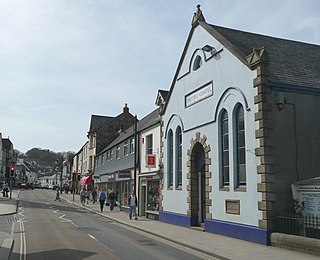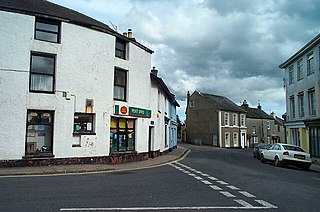
Okehampton is a town and civil parish in West Devon in the English county of Devon. It is situated at the northern edge of Dartmoor, and had a population of 5,922 at the 2011 census. Two electoral wards are based in the town. Their joint population at the same census was 7,500.

Chagford is a market town and civil parish on the north-east edge of Dartmoor, in Devon, England, close to the River Teign and the A382, 4 miles (6 km) west of Moretonhampstead. The name is derived from chag, meaning gorse or broom, and the ford suffix indicates its importance as a crossing place. At the 2011 Census, it had a population of 1,449.

West Devon is a local government district with borough status in Devon, England. Its council is based in Tavistock, the borough's largest town. The borough also includes the towns of Hatherleigh, North Tawton and Okehampton, along with numerous villages and surrounding rural areas.

Manaton is a village situated to the southeast of Dartmoor National Park, Devon, England.

South Tawton is a village, parish and former manor on the north edge of Dartmoor, Devon, England. An electoral ward bearing the same name exists. At the 2011 census the population was 1,683.

Belstone is a small village and civil parish in the West Devon District of Devon, England.

Lustleigh is a small village and civil parish in the Wray Valley, inside the Dartmoor National Park in Devon, England. It is between the towns of Bovey Tracey and Moretonhampstead. The village has often been named in various publications as being amongst the best or prettiest villages in the country, particularly due to the traditional thatched buildings in the village centre, and local activities such as the Lustleigh Show. That has also led to it being noted as the most expensive rural location in which to buy a house.

Arlington was a manor, and is a village and civil parish in the North Devon district of Devon in England. The parish includes the villages of Arlington and Arlington Beccott. The population of the parish is 98.

Chittlehampton is a village and civil parish in the North Devon district of Devon, England, about 7 miles (11 km) south-west of Barnstaple. At the 2001 census, the parish had a population of 820.

Zeal Monachorum is a village and civil parish in the Mid Devon district of Devon, England, about 18 miles (29 km) north-west of Exeter, situated on the River Yeo. According to the 2001 census, it had a population of 398. The village is in the electoral ward of Taw whose population at the 2011 Census was 1,660.

Copplestone is a village, former manor and civil parish in Mid Devon in the English county of Devon. It is not an ecclesiastical parish as it has no church of its own, which reflects its status as a relatively recent settlement which grew up around the ancient "Copleston Cross" that stands at the junction of the three ancient ecclesiastical parishes of Colebrooke, Crediton and Down St Mary.

South Brent is a large village on the southern edge of Dartmoor, England, in the valley of the River Avon. The parish includes the small hamlets of Aish, Harbourneford, Lutton, Brent Mill, and many scattered farmhouses. It is five miles (8 km) north-east of Ivybridge and 14 miles (22 km) east-northeast of Plymouth.

Whitstone is a village and civil parish in east Cornwall, England, United Kingdom. It is roughly halfway between the towns of Bude and Launceston. The population at the 2011 census was 590.

Tavistock Abbey, also known as the Abbey of Saint Mary and Saint Rumon, is a ruined Benedictine abbey in Tavistock, Devon. The Abbey was surrendered in 1539 during the Dissolution of the Monasteries. Nothing remains of the abbey except the refectory, two gateways and a porch. The abbey church, dedicated to Our Lady and St Rumon, was destroyed by Danish raiders in 997 and rebuilt under Lyfing, the second abbot. The church was further rebuilt in 1285 and the greater part of the abbey between 1457 and 1458.

Cheriton Bishop is a village and civil parish situated on the northern borders of Dartmoor National park between Exeter and Okehampton, in Devon, England. The population at the 2011 Census was 652. The history of the settlement can be traced back over a thousand years when the old village centre was established as a commercial centre for the local farming community.

Witheridge is a village and civil parish in the North Devon district of Devon, England. In 2001 the population of the parish was 1162, reducing slightly to 1,158 at the 2011 Census. An electoral ward with the same name exists. The population at the above census was 2,313. Its name may be derived from the Old English for "Weather Ridge", which would fit with the village's somewhat exposed situation.
Dartmoor Forest is a civil parish in Devon, England. It was formed in 1987 by the splitting of the former parish of Lydford. It covers about 56,000 acres (230 km2) entirely within Dartmoor National Park, and is the largest parish in Devon. Despite its size its population in 2001 was only 1,619. Due to its large size it is surrounded by many other parishes: these are, clockwise from the north, Belstone, South Tawton, Throwleigh, Gidleigh, Chagford, North Bovey, Manaton, Widecombe in the Moor, Holne, West Buckfastleigh, Dean Prior, South Brent, Ugborough, Harford, Cornwood, Shaugh Prior, Sheepstor, Walkhampton, Whitchurch, Peter Tavy, Lydford, land common to the parishes of Bridestowe and Sourton, and Okehampton Hamlets.

Fowelscombe is a historic manor in the parish of Ugborough in Devon, England. The large ancient manor house known as Fowelscombe House survives only as an ivy-covered "romantic ruin" overgrown by trees and nettles, situated 1 mile south-east of the village of Ugborough. The ruins are a Grade II listed building.

North Wyke is an historic manor in the parish of South Tawton, Devon. The surviving grade I listed manor house, the original Devonshire seat of the Wyke family from the early 13th century to 1714, retains its basic mediaeval form, but was "improved and reconstructed" by Rev. William Wykes-Finch (d.1920) in 1904, historian and descendant of the Wyke family, to the design of G.H. Fellowes Prynne. Currently, the manor is part of Rothamsted Research's North Wyke site.

Fardel is a historic manor in the parish of Cornwood, in the South Hams district of Devon. It was successively the seat of the Raleigh and Hele families. The surviving Grade I listed medieval manor house is situated about half-way between Cornwood and Ivybridge, just outside the Dartmoor National Park on its south-western border.



















